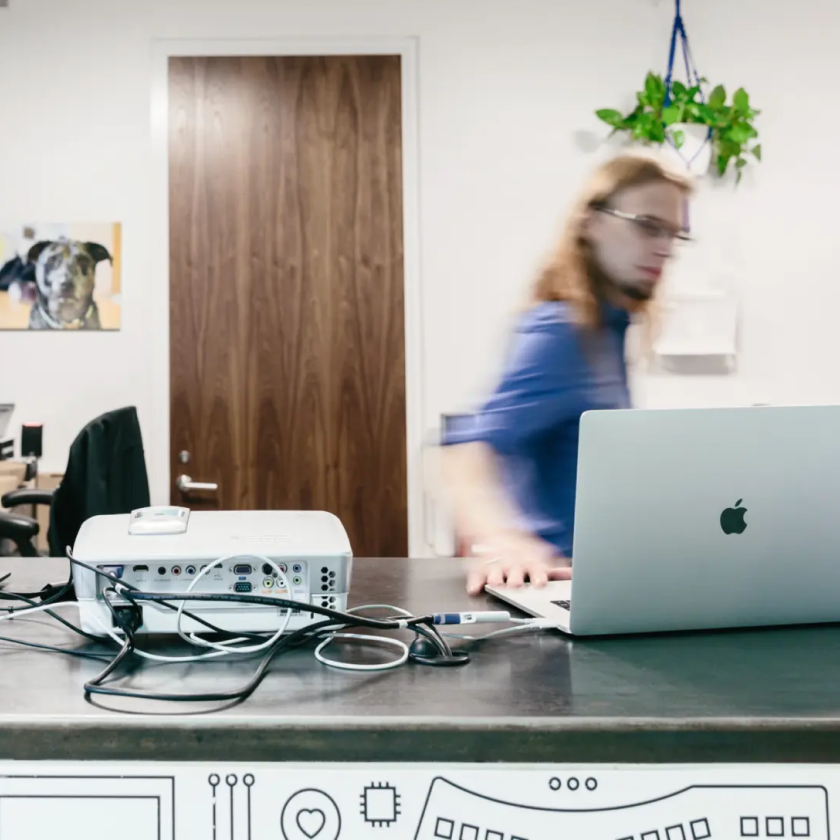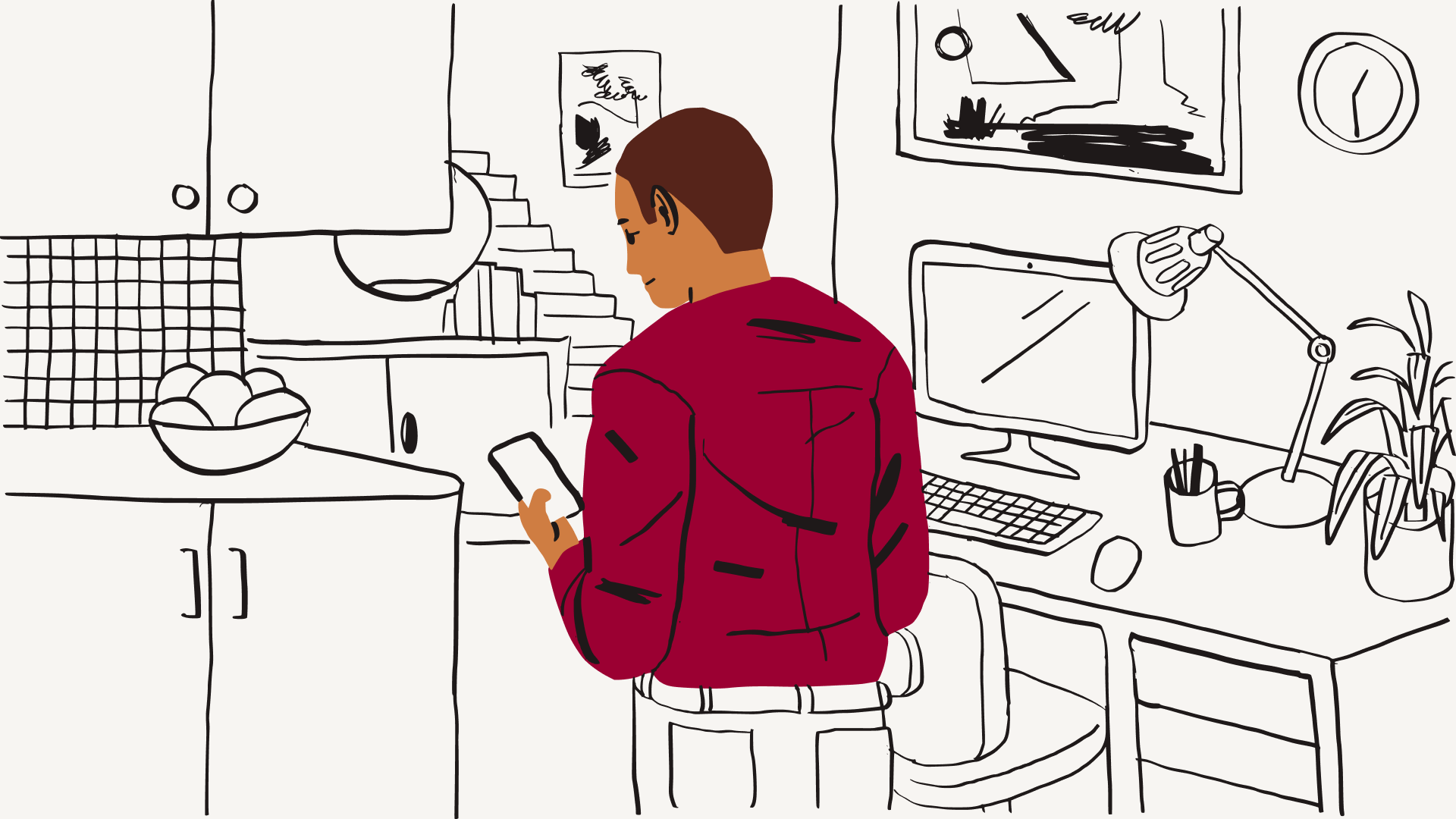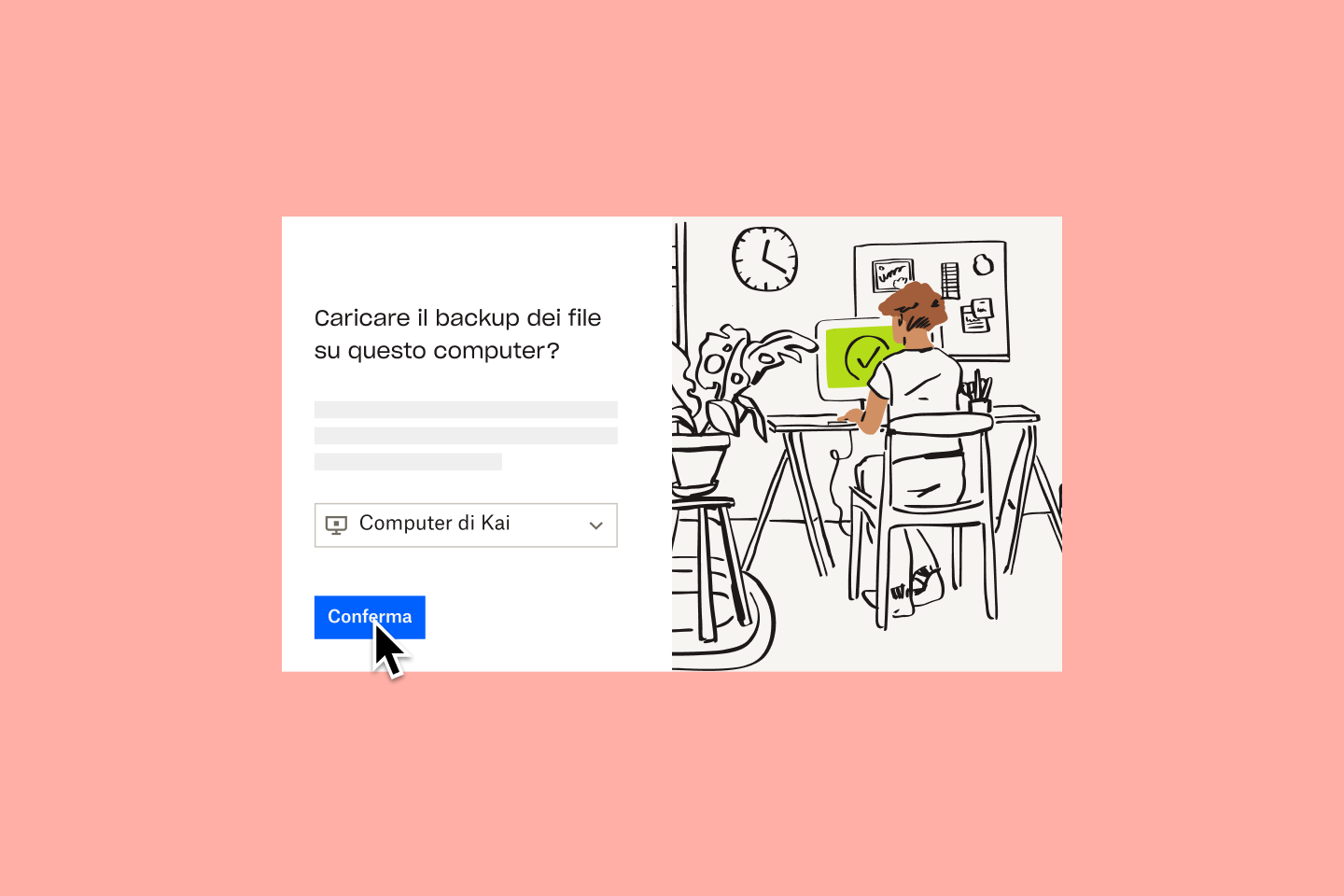Table of contents
- 1. Trasferimento manuale con un hard disk esterno
- 2. Cavo di trasferimento dati
- 3. Trasferimento locale tramite Wi-Fi o LAN
- 4. Trasferimento tramite spazio di archiviazione cloud
- 5. Software specifico per la migrazione dei contenuti del PC
- 6. Utilizzo di Dropbox Backup per trasferire i file su un nuovo PC
- Cosa fare dopo il trasferimento dei file
- Esegui il backup dei tuoi file con Dropbox, per una migrazione rapida e semplice
Ecco uno scenario comune: hai appena aperto il tuo laptop nuovo di zecca, lo hai configurato ed è tutto pronto per iniziare a lavorare, ma poi ti ricordi che hai 2 TB di file salvati sul tuo vecchio PC e solo una chiavetta USB da 2 GB per trasferirli manualmente.
Qual è quindi il modo migliore per trasferire dati da un computer all’altro? Per fortuna, trasferire file di grandi dimensioni non è un processo troppo complicato; tuttavia, il metodo da utilizzare dipende da alcuni fattori, come il sistema operativo dei computer coinvolti e il numero di file da trasferire.
Allora quali sono le tue opzioni?
Come si trasferiscono i dati da un computer all’altro?
Con il metodo giusto, trasferire dati da un computer all’altro può essere un gioco da ragazzi. Ecco sei modi per farlo, ciascuno adatto a diverse esigenze.
- Utilizzare un hard disk esterno: questa soluzione semplice e una tantum non richiede alcun software o connessione a Internet, ma comporta il rischio di perdita, danneggiamento o compromissione del dispositivo fisico.
- Utilizzare un cavo per il trasferimento dei dati: collega direttamente due PC vicini per un trasferimento rapido ed efficiente tramite il software integrato. Assicurati solo che entrambi i dispositivi siano accesi e pronti all’uso; potrebbe essere necessario installare un software aggiuntivo.
- Trasferire i file localmente tramite Wi-Fi o LAN: questo metodo è sicuro e veloce, il che lo rende ideale per trasferire file tra PC sulla stessa rete. La velocità dipenderà dalla connessione Internet.
- Trasferire i file tramite spazio di archiviazione cloud: utilizzando fornitori di spazio di archiviazione cloud come Dropbox, i trasferimenti di file sono sicuri, scalabili e accessibili da qualsiasi dispositivo. Per iniziare basta avere un account e una connessione Internet stabile.
- Utilizzare un software specializzato per la migrazione del PC: ideale per trasferimenti di sistemi completi e per settori che richiedono maggiore sicurezza; questa opzione è altamente personalizzabile, ma può comportare costi elevati e richiedere una connessione Internet.
- Utilizzare Dropbox Backup: per una soluzione di backup e ripristino altamente sicura e scalabile che funziona su diversi sistemi operativi, Dropbox Backup è la scelta giusta. Ripristina persino i file nelle loro posizioni originali.
Analizziamo più nel dettaglio ciascun metodo, così potrai scegliere quello più adatto alla tua configurazione.
1. Trasferimento manuale con un hard disk esterno
Un hard disk esterno è un dispositivo di archiviazione fisico che consente di copiare file da un PC e spostarli su un altro, senza bisogno di una connessione Internet o di software aggiuntivi.
Ecco come funziona il processo di trasferimento manuale:
- Passaggio 1: collega il disco rigido esterno al tuo vecchio PC.
- Passaggio 2: apri Esplora file e trascina i file o le cartelle che desideri trasferire nell’unità.
- Passaggio 3: espelli in modo sicuro il disco rigido e collegalo al nuovo PC.
- Passaggio 4: apri l’unità in Esplora file e sposta i file nella nuova posizione.
Gli hard disk esterni sono ideali per trasferire i file quando non si dispone di una connessione a Internet o non si ha il tempo di scaricare e installare un software di trasferimento. In questo caso, un hard disk esterno offrirà il tipo di trasferimento rapido e diretto di cui si ha bisogno.
Molti hard disk esterni sono relativamente piccoli e leggeri; tuttavia, trattandosi di dispositivi fisici, sono facilmente soggetti a furto e smarrimento. Ci siamo passati tutti, soprattutto con i sistemi di archiviazione flash più piccoli, come le chiavette USB e le schede di memoria.
Ricorda: i tuoi dati non vengono automaticamente crittografati né protetti da password quando li copi su un hard disk esterno. Se il dispositivo venisse rubato o smarrito, i tuoi file potrebbero essere seriamente a rischio.
Vantaggi
- trasferimento semplice e diretto
- software non necessario
- compatto e portatile
- acquisto una tantum
Svantaggi
- i dispositivi fisici sono soggetti a danni, furti e corruzione
- capacità limitate
- non sicuro
2. Cavo di trasferimento dati
I cavi di trasferimento sono un metodo collaudato per trasferire file tra due PC relativamente vicini (ad esempio, sulla stessa scrivania).
Ecco come trasferire file su un nuovo computer utilizzando un cavo per il trasferimento di dati:
- Passaggio 1: collega il cavo a entrambi i PC utilizzando le porte USB appropriate.
- Passaggio 2: avvia il software fornito con il cavo (solitamente si installa automaticamente).
- Passaggio 3: seleziona i file o le cartelle che desideri trasferire e inizia il processo.
Tieni presente che per trasferire dati via cavo, i PC devono essere vicini e accesi contemporaneamente. Ciò significa che il nuovo PC deve essere già configurato e pronto all’uso prima di ricevere i trasferimenti di file.
Vantaggi
- software integrato che automatizza il processo di trasferimento
- più veloce rispetto agli hard disk esterni
Svantaggi
- i PC devono essere vicini e accesi contemporaneamente
- spesso richiede il download e l’installazione di un software che verrà utilizzato una sola volta
Posso trasferire i file con un cavo HDMI?
Il trasferimento di file via cavo è possibile solo con un cavo specifico per il trasferimento di dati; pertanto, è molto difficile che possa essere effettuato con un cavo HDMI, USB o altri cavi presenti in casa, come il cavo di alimentazione del laptop o del telefono.
Se hai bisogno di un trasferimento immediato dei file, un software o una soluzione basata sul web potrebbero rappresentare un’opzione migliore. Con il trasferimento via cavo, infatti, non solo dovresti uscire di casa per acquistare un cavo di trasferimento (o aspettare che te lo consegni il corriere), ma il processo di trasferimento è anche relativamente lento rispetto ai metodi alternativi.

3. Trasferimento locale tramite Wi-Fi o LAN
Le reti Wi-Fi e LAN sono due mezzi che puoi utilizzare per trasferire i file e le cartelle tra due PC che si trovano nelle immediate vicinanze.
Tramite una rete LAN, puoi lavorare su un PC mentre sfogli l’hard disk interno di un altro PC per selezionare i file da trasferire. Finché i computer sono collegati allo stesso router o alla stessa rete, la connessione LAN consente a questi dispositivi di riconoscersi ogni volta che devi effettuare un trasferimento.
Trasferire file tramite Wi-Fi con Windows 10 o 11:
È possibile utilizzare la funzionalità Condivisione nelle vicinanze per trasferire file su un nuovo PC in modalità wireless tramite Wi-Fi.
- Passaggio 1: assicurati che entrambi i PC siano collegati alla stessa rete Wi-Fi.
- Passaggio 2: abilita Condivisione nelle vicinanze nelle impostazioni di sistema.
- Passaggio 3: fai clic con il pulsante destro del mouse sul file che desideri inviare e seleziona Condividi.
- Passaggio 4: seleziona il PC ricevente dall’elenco dei dispositivi disponibili.
Trasferire file tramite Wi-Fi su un Mac:
È possibile usare AirDrop, Assistente Migrazione o Condivisione File per spostare i file in modalità wireless tra Mac collegati alla stessa rete.
- Assicurati che entrambi i Mac siano connessi alla stessa rete Wi-Fi o LAN.
- Per inviare solo pochi file: usa AirDrop dal Finder per inviare file in modalità wireless a un Mac vicino.
- Per trasferimenti completi del sistema: avvia Assistente Migrazione e segui le istruzioni per trasferire dati e impostazioni.
- Per abilitare l’accesso alla rete, vai su Impostazioni di sistema > Generali > Condivisione e attiva Condivisione file.
- Facoltativo: puoi anche configurare il tuo Mac come destinazione di backup di Time Machine, così da avere accesso costante e backup automatici.
Trasferire file tramite LAN:
Per i trasferimenti basati su LAN, assicurati che entrambi i computer siano collegati alla stessa rete gestita da router. Questo consente di esplorare i file di un PC direttamente dall’altro.
Evita di trasferire file su reti pubbliche o non protette, come quelle presenti nei bar o nelle biblioteche. Le reti private sono più sicure e affidabili per questo tipo di trasferimenti locali.
Poiché i trasferimenti Wi-Fi e LAN richiedono una connessione Internet, questi metodi devono essere utilizzati solo quando la rete è privata e sicura. In altre parole, non trasferire file mentre sei connesso a una rete pubblica, in un bar o in una biblioteca.
Vantaggi
- sicuro, solo su rete privata
- hardware esterni o unità flash non necessari
- veloce
Svantaggi
- la velocità di trasferimento dipende dalla potenza della connessione Internet
- i PC devono essere vicini tra loro

4. Trasferimento tramite spazio di archiviazione cloud
Lo spazio di archiviazione cloud rappresenta uno dei metodi più semplici e flessibili per trasferire file tra computer. Non richiede dispositivi fisici o cavi e i file sono accessibili da qualsiasi luogo con una connessione Internet.
Qualsiasi file trasferito attraverso il cloud è protetto dalla crittografia dei dati. Inoltre, a differenza degli hard disk esterni, un servizio di archiviazione cloud è scalabile, il che significa che sottoscrivi un abbonamento in base allo spazio di cui hai bisogno.
Ecco come trasferire file da un computer a un altro utilizzando Dropbox:
- Passaggio 1: scarica e installa l’applicazione Dropbox per desktop su entrambi i PC.
- Passaggio 2: accedi al tuo account Dropbox su ogni dispositivo.
- Passaggio 3: sul tuo vecchio PC, apri l’app Dropbox e individua i file o le cartelle che desideri spostare.
- Passaggio 4: trascina e rilascia i file nella cartella Dropbox per iniziare il caricamento.
- Passaggio 5: sul tuo nuovo PC, apri la cartella Dropbox e sposta i file dove preferisci.
Una volta caricati, i file saranno disponibili nella cartella Dropbox su entrambi i PC. Puoi lasciarli lì o spostarli altrove sul nuovo dispositivo.
Importante: assicurati di disconnetterti e disinstallare Dropbox sul vecchio PC prima di cancellare o eliminare i file. Se entrambi i dispositivi sono connessi, eliminando un file sincronizzato su uno di essi, lo si rimuoverà anche dall’altro.
Se cerchi un modo per trasferire solo alcuni file dal tuo PC a quello di un’altra persona, le funzionalità di condivisione dei file nello spazio di archiviazione cloud sono un metodo efficiente per trasferire i tuoi dati. Basta fare clic con il pulsante destro del mouse sul file archiviato nel cloud e selezionare Condividi.
Vantaggi
- i dati sono protetti tramite crittografia
- non richiede un dispositivo fisico
- scalabile
- non è necessario che i PC siano vicini tra loro
Svantaggi
- abbonamento necessario
- la velocità di trasferimento dipende dalla velocità della connessione Internet
5. Software specifico per la migrazione dei contenuti del PC
Gli hard disk esterni e i cavi per il trasferimento dei dati sono soluzioni valide quando ci sono pochi file e cartelle da trasferire. Ma cosa succede quando devi eseguire la migrazione di tutti i contenuti dal vecchio PC a quello nuovo?
In questo caso, è necessario un software di migrazione del PC, ossia un programma creato per gestire enormi quantità di dati senza compromettere la sicurezza dei file. Esistono strumenti specializzati nel trasferimento di tipi di dati specifici, come ad esempio le email.
Se lavori in un settore fortemente regolamentato, il tuo PC potrebbe contenere molti dati sensibili, come le informazioni sanitarie protette (PHI) del settore sanitario. Per trasferire questi dati, è necessario affidarsi a un software specifico per la migrazione che offra un protocollo di trasferimento file sicuro (SFTP).
Gli strumenti SFTP sono consigliati per trasferire dati su larga scala da un sito all’altro o da una rete all’altra e sono particolarmente utili in quegli ambiti in cui la riservatezza delle informazioni è fondamentale, come la finanza e il settore legale.
Uno dei vantaggi dei software di migrazione del PC è che consentono di applicare le impostazioni del vecchio PC a quello nuovo. Tuttavia, si tratta di un software che deve essere acquistato e scaricato da terze parti, il che potrebbe rappresentare un costo elevato per un servizio che probabilmente viene utilizzato una volta sola.
Vantaggi
- più personalizzabile rispetto a cavi e hard disk esterni
- altamente sicuro
Svantaggi
- abbonamento necessario
- la velocità di trasferimento dipende dalla potenza della connessione Internet

6. Utilizzo di Dropbox Backup per trasferire i file su un nuovo PC
Dropbox Backup semplifica il trasferimento dei file su un nuovo PC ripristinando l’intero file system dal cloud in pochi clic. Ciò consente di ripristinare i file su un nuovo PC senza dover ricorrere a lente connessioni manuali da computer a computer.
In pochi clic, puoi eseguire il backup dei file e delle cartelle dal vecchio PC e successivamente recuperarli dal backup sul nuovo dispositivo o conservarli al sicuro nel tuo account. I file verranno ripristinati nella rispettiva posizione originale sul tuo dispositivo, così potrai riprendere il lavoro esattamente da dove lo avevi interrotto, senza dover riordinare i dati recuperati nelle cartelle. Questo metodo è particolarmente utile se si passa da un sistema operativo all’altro, ad esempio da un Mac a un PC Windows.
La configurazione una tantum ti consente di archiviare i file salvati in tutti i tuoi computer in un unico posto sicuro. Se hai dei dati salvati su hard disk esterni, ti basta collegarli al computer e noi eseguiremo il backup anche di quelli.
Ecco come funziona il processo di trasferimento dei file su un nuovo PC con Dropbox Backup:
- Passaggio 1: configura Dropbox Backup sul tuo vecchio computer e seleziona i file e le cartelle di cui desideri eseguire il backup.
- Passaggio 2: attendi il completamento del backup (l’operazione potrebbe richiedere del tempo a seconda delle dimensioni dei file).
- Passaggio 3: sul tuo nuovo PC, installa Dropbox Backup, accedi allo stesso account Dropbox e avvia il processo di ripristino.
- Passaggio 4: Dropbox ripristinerà quindi i file nelle loro posizioni originali sul nuovo dispositivo.
Vantaggi
- opzione altamente sicura
- ripristino immediato dei file in caso di trasferimento errato
- ripristino dei file nella loro posizione originale
- scalabile e con funzionamento su più dispositivi
- consente di recuperare i file rapidamente, ma anche di archiviarli a lungo termine
- ripristina i file nella rispettiva posizione originale sul computer
Svantaggi
- abbonamento necessario per continuare a utilizzare il servizio e proteggere i file
- la velocità di trasferimento dipende dalla velocità della connessione Internet

Cosa fare dopo il trasferimento dei file
Una volta trasferiti tutti i file sul nuovo PC, hai altri passaggi da seguire. Alcuni passaggi finali ti permettono di proteggere i dati e rendere il vecchio dispositivo pronto per il riciclo, la vendita o lo smaltimento in sicurezza.
Passaggio 1: cancella i dati dal tuo vecchio PC
Anche dopo aver spostato tutti i file sul nuovo PC, nel vecchio computer potrebbero essere presenti dei dati che ti sono sfuggiti. Ecco perché è importante pulire completamente il vecchio PC prima di smaltirlo.
Cancellare i dati dal tuo vecchio PC su Windows 8 e versioni successive:
- Vai su Impostazioni > Ripristino.
- Seleziona l’opzione Ripristina per rimuovere tutti i file personali e ripristinare le impostazioni di fabbrica.
Cancellare i dati dal tuo vecchio PC su Windows 10 o 11:
- Vai su Impostazioni > Ripristino.
- Seleziona l’opzione Ripristina PC per rimuovere tutti i file personali e ripristinare le impostazioni di fabbrica.
- Ti verrà chiesto di reinstallare Windows utilizzando uno dei metodi riportati di seguito.
- Download dal cloud: scarica nuovi file di sistema dai server Microsoft.
- Reinstallazione locale: reinstalla utilizzando i file già presenti sul PC.
- Utilizza Download dal cloud se disponi di una connessione Internet veloce e stabile oppure Reinstallazione locale se intendi riciclare il dispositivo e preferisci non fare affidamento sulla connessione.
Passaggio 2: esegui il backup del tuo nuovo PC
Alcuni metodi di trasferimento che abbiamo illustrato, come hard disk esterni, spazio di archiviazione cloud e Dropbox Backup, soddisfano più requisiti di gestione dei file, in quanto non solo offrono un sistema per trasferire i file, ma sono anche soluzioni di backup dei dati.
Un backup è la copia di un file che può essere ripristinata se il file originale viene perso o danneggiato. Eseguire il backup dell’intero PC significa garantire che ogni file e cartella del sistema sia recuperabile, anche in caso di imprevisti durante il processo di trasferimento dei dati.
Con una soluzione di backup nel cloud come Dropbox Backup, proteggere i tuoi file non è mai stato così semplice. Ti basta caricare i file e le cartelle sul tuo account Dropbox e noi ne eseguiremo il backup automatico a intervalli regolari: facile, no?
Esegui il backup dei tuoi file con Dropbox, per una migrazione rapida e semplice
Dropbox Backup semplifica il backup automatico dei file su cloud per consentirti di eseguire la migrazione dei file da un PC all’altro in modo rapido e semplice.


